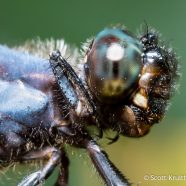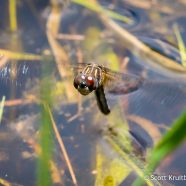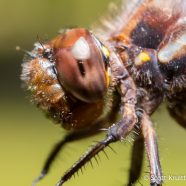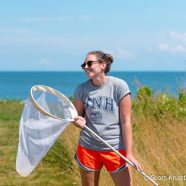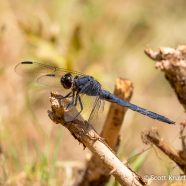Spangled Skimmer
Here is a male Spangled Skimmer (Libellula cyanea) which felt very appropriate for the Fourth of July. Happy Independence Day to all! We hope you are enjoying the holiday outside with our natural friends.
Read MoreFemale Blue Dasher Ovipositing
How cool does this hovering aircraft look? This female Blue Dasher (Pachydiplax longipennis) is ovipositing, laying eggs, into aquatic vegetation in a pond as photographed last week. As you can see they are quite skilled at keeping their head still while their wings are whipping and the abdomen is being pressed into the water.
Read MoreCommon Whitetail
Can you identify this extra close friend? Here we have the Common Whitetail (Plathemis lydia) dragonfly with this male being cooperative in hand for a moment as I took a look at those eyes and that face. Birds in hand look very much like…birds…you know, the ones we see from afar with our eyes, binoculars, and spotting scopes. Dragonflies often look so very different as the features we see while they are flitting through the air – stripes on the thorax or abdomen, colored wings, an overall body shade – are lost in the details of their complex face, head, and even...
Read MoreWildLife Guards Training – Netting Dragonflies
Training week for the Bridgeport WildLife Guards Crew Leaders continues! We will be adding some new lesson plans and activities for the WildLife Guards this year both in conservation survey work and educational outreach. While much of our work is focused on birds we felt that considering Pleasure Beach is an important migratory hub for butterflies and dragonflies that we should teach the WildLife Guards about some of the insects that they can expect to see moving through the gardens and fields of milkweed, goldenrod and so forth. I created a couple lists of ten expected butterfly and...
Read MoreSlaty Skimmer
This Slaty Skimmer (Libellula incesta) is not hanging out in the desert, though it may look like that from this photo. Much of the region is running a strong rainfall deficit from the past few months with many areas abnormally dry and some in the midst of moderate drought. This combined with higher than average temperatures and aggressive destruction of vegetation in areas around ponds like this one (I promise there is a pond out of sight in this photo with actual water) can make what was a favorable area for insects and thus birds and other wildlife far less attractive and beneficial. Water...
Read More



